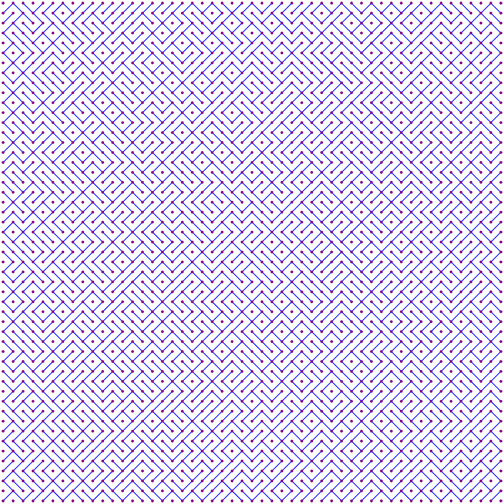I'll use the theorem on intersecting separations known from the topological dimension theory.
Consider rectangular $\ (m\!\times\! n)$-grid $\,\ 0..m\times 0..n\ $ -- here, I am applying Perl notation:
$$ x..y\,\ :=\,\ \{k\in\Bbb Z:\, x\le k\le y\} $$
An unordered pair, $\ (v\ w)\ $ and $\ (x\ y),\ $ of points of this grid, forms a small diagonal $\ (v\ w;\ x\ y),\ $, or a smad for short, $\ \Leftarrow:\Rightarrow\ $
$$ \forall_{(v\ w;\ x\ y)\,\in\,D}\quad |v-x|=|w-y|=1 $$
Let $\ D:=D_{mn}\ $ be the set of all smads. There is the direction function $\ d:D\to\{0\ 1\}\ $ defined as follows:
$$ d(v\ w;\ x\ y)\ :=\ \frac 12\cdot|x+y - v-w| $$
Each grid cell has two smads, say $\ \gamma\,$ and $\,\delta,\ $ and they have different directions, say $ d(\gamma)=0\ $ and
$\ d(\delta)=1,\ $ or vice versa, $\ d(\gamma)=1\ $ and
$\ d(\delta)=0.$
Furthermore, each smad $\ \delta:=(v\ w;\ x\ y)\ $ has its color
$\ C(\delta)\in \Bbb Z/2:$
$$ C(\delta)\ :=\ x+y+d(\delta)\ \mod 2 $$
A smad configuration is any function $\ f:1..m\times 1..n\to D\ $
such that
$$ f(x\ y)\ =\ (x\!-\!1\,\ y\!-\!1;\ \ x\ y)\qquad\text{or}
\qquad f(x\ y)\ =\ (x\!-\!1\,\ y;\ \ x\,\ y\!-\!1) $$
for every $\ (x\ y)\ \in\ 1..m\times1..n.\ $
Remark It helps (psychologically) to identify $\ (x\ y)\ $ with the square which has
$$ (x\ y)\qquad (x\!-\!1\,\ y)\qquad(x\,\ y\!-\!1)
\qquad (x\!-\!1\,\ y\!-\!1) $$
as its vertices.
Each configuration $\ f\ $ induces a 2-coloring of the
Euclidean rectangle $[0;m]\times[0;n].\ $ Let Black/White color be $\ 0/1\ (\!\!\!\mod 2)\ $ respectively; the colored areas are closures of
$\ \overline {\mathcal B}\ $ and $\ \overline{\mathcal W},\ $ and they slightly overlap:
$$ \mathcal B\ :=\ \{0\,\ m\}\times [0;n]\ \cup
\ \{(s\ t)\in (0;m]\times(0;n]
\,\ (C\circ f)(\lceil s\rceil\ \lceil t\rceil)\ =\ 0\} $$
and
$$ \mathcal W\ :=\ [0;m]\times \{0\,\ n\}\ \cup
\ \{(s\ t)\in (0;m]\times(0;n]
\,\ (C\circ f)(\lceil s\rceil\ \lceil t\rceil)\ =\ 1\} $$
Now is the time to define the West/East and South/North four areas,
$\ M_0\ M_m\,\ N_0\ N_n:$
- $\ M_0\ $ is the connected component of $\ \{0\}\!\times\![0;n]\ $
of color $\ \overline{\mathcal B};$
- $\ M_m\ :=\ \overline{\mathcal B}\setminus M_0\quad $ (yes, $\ M_m\ $
is closed);
- $\ N_0\ $ is the connected component of $\ [0;n]\!\times\!\{0\}\ $
of color $\ \overline{\mathcal W};$
- $\ N_n\ :=\ \overline{\mathcal W}\setminus N_0\quad $ (yes, $\ N_n\ $
is closed);
If $\ M_0\cap M_m\ne\emptyset\ $ or $\ N_0\cap N_n\ne\emptyset\ $
then the theorem holds -- there exists the respective required paths.
And this is actually the case. Otherwise, there would be closed
sets $\ V\ H\ $ which are the (vertical and horizontal respectively) separators between $\ M_0\ $ and $\ M_m\ $ as well as between
$\ N_0\ $ and $\ N_n\ $ respectively. This means (by a classical
topological dimension theory) that $\ V\cap H\ne\emptyset.\ $
Thus, let certain $\ (s\ t)\in V\cap H.\ $ Since $\ (s\ t)\in V $
we get $\ f(\lceil s\rceil\ \lceil t\rceil)\ \ne\ 0\ $ (is not Black);
Since $\ (s\ t)\in H $
we get $\ f(\lceil s\rceil\ \lceil t\rceil)\ \ne\ 1\ $ (is not White).
A contradiction. End of proof.
I have proved above a more precise version of the puzzle-theorem proposed by OP, namely:
THEOREM For every configuration of cell diagonals, there is a West-East path across the grid of color black or a South-North path across the grid of color 1.
End of Theorem
This leads to a game similar to a game by Shannon (except that it is less natural than Shannon's game). Two players alternatively select cells of one color or another. The one who connects two opposite sides -- East and West by the first player or North and South by the second player -- wins. My precise formulation shows that there is always a winner -- this is due to 2-dim FPP. Then it follows that the winner can be always the first player -- this theorem is achieved by the borrowing strategy approach (both stages are just like in the case of Shannon's game).

